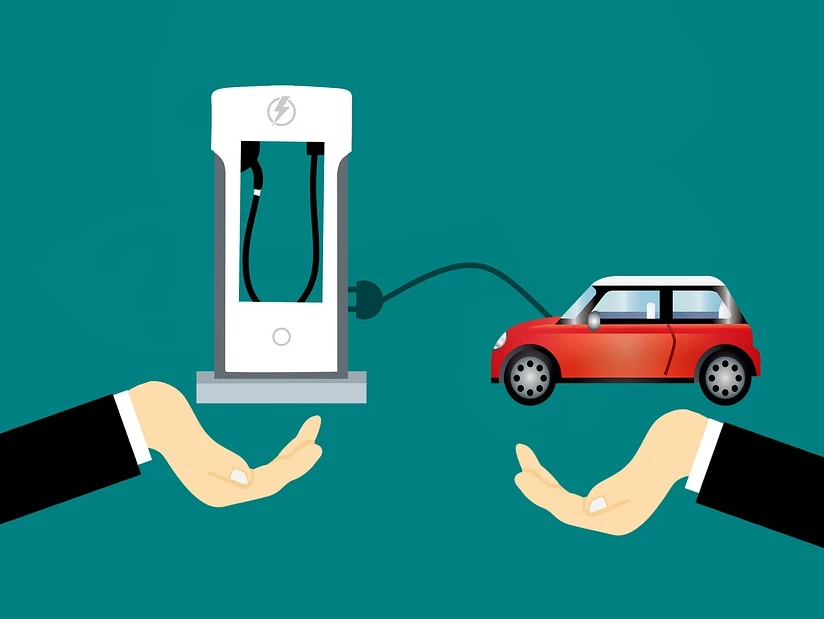Many advantages of EV adoption are well known—decreased emissions, improved air quality, reduced dependence on foreign oil and oil drilled in sensitive ecosystems, and about $11,000 in fuel savings over the course of its lifetime. Less well understood are the savings an EV owner passes on to other consumers via lower oil prices. In a previous blog post, we discussed how small drops in oil demand result in large drops in oil prices, meaning that any action which subtracts from oil demand will result in large savings to consumers of oil products—products including gasoline, jet fuel, fertilizers, and asphalt. Skibo’s calculations show that the savings to oil consumers generated by just one passenger EV is about $100,000, easily covering the price tag of all but the most luxurious EV models. In what follows, we’ll walk through our logic, which suggests that governments should be taking a much more aggressive stance on EV adoption—even to the point of simply giving them away.
Oil Elasticity—A Brief History
Recent history makes clear that a relatively small, short-term drop in oil demand leads to an exponential drop in price. We saw evidence of this in 2008 when, over a six-month period, a 3% drop in demand led to a 70% drop in price, and again, in the Spring of 2020, when a sudden decline in demand briefly resulted in negative oil futures. But these were short-term shocks, which caught suppliers off guard, and therefore don’t provide a clear picture of how the market might respond to a more gradual and expected decline in oil demand (such as will occur through the adoption of EVs). For that we must look back to the 1970s, when the introduction of vehicle efficiency standards (officially, the Corporate Average Fuel Economy standards or CAFE) contributed to a sharp decline in oil demand, resulting in lower oil prices for decades.
Source: USDOT
Source: EIA (for period 1973-2017), Hook, Michael (for period 1965-1973)
Source: BP Statistical Review of World Energy 2021
(In the three graphs above, the green column highlights the twelve-year period following the introduction of CAFE standards, demonstrating the close correlation between changes in the US fleet’s efficiency, global oil production and price)
First implemented in 1978 in response to declining U.S. control of oil (and oil prices), CAFE standards were intended to double the average fuel economy of the new passenger vehicle fleet—a gradual process, implemented over a roughly twelve-year period. By regulating for more efficient vehicles, and therefore lowering fuel consumption, CAFE standards eventually helped drop oil demand (and production) by about 20%. In the same period, prices gradually fell from a high of $120 per barrel in 1980 to below $40 (inflation adjusted), where they would remain until the 2000s. In other words, a long-term, 20% drop in demand was accompanied by a 70% drop in price. (It’s worth noting that during the first years of the new standards, OPEC curtailed production in an effort to defend higher prices—a strategy they were eventually forced to abandon in the mid 80s, resulting in prices briefly falling below $24 per barrel)
In consideration of the events of the 1980s, and an IMF study suggesting that a 1% drop in long-term demand will result in a 14% drop in long-term price, Skibo estimates that a drop in demand of ~5% over the course of several years will result in a roughly 50% drop in price. We believe this is a conservative estimate, and that savings could be far greater—in part, depending on how fast we transition to oil-alternatives.
EVs Drop the Price of Oil
If we assume that every EV sold represents an ICE vehicle not driven, then we can conclude that EVs cause a negative effect on the demand for oil, commensurate with the oil needs of the ICE vehicle foregone. In this way, the replacement of ICE vehicles with EVs causes a downward pressure on oil price. So how many EVs will it take to significantly reduce the price of oil and thus create massive savings for oil consumers?
If we take a 50% reduction in oil price as our goal, then we require that enough EVs are sold to reduce demand for oil by 5%. (As suggested in the last section) 5% of all oil produced in 2019—the last year for which we have “normal” data—is 1.8 billion barrels. A typical ICE vehicle uses between 11.3 and 15.6 barrels of oil each year, depending on the type of vehicle. Considering current buying preferences—assuming 72% of EVs sold will replace an ICE truck or SUV and 28% will replace a car—we predict it would take selling 126 million EVs to drop oil demand by 1.8 billion barrels (or 5% of 2019 demand), pushing oil prices below $35 per barrel.
Using BloombergNEF’s Electric Vehicle Outlook 2021, we expect there to be at least this number of EVs on the road by 2029. With supportive government legislation, manufacturers may reach this milestone even earlier, especially in consider of recent, large (and increasing) investments by legacy auto manufacturers, new startups, and Tesla in EV production.
(Note: in previous materials, we used more optimistic ICE vehicle assumptions—20,000 miles per year and 23 mpg—which determined that the sale of only 80 million EVs would cause a ~50% drop in price. A more realistic calculation, based on governmental data sources, was used above.)
Source: BNEF Electric Vehicle Outlook 2021
Calculating Return on Investment
In 2019, countries that paid market prices for oil—in our estimation at least 65% of total consumption—spent over $1.5 trillion. If 126 million EVs on the road results in 50% savings on oil prices, that means these countries’ oil consumers will save roughly $730 billion each year from the widespread adoption of electric vehicles, or about $5,700 per vehicle, per year it’s on the road. Over a seventeen-year lifespan an EV will save oil consumers $100,000.
This is an average and there are several caveats worth further explaining. First, EVs sold today will drive most of their lifetime miles prior to the 5% threshold we predict will produce 50% in savings for oil consumers. But that doesn’t mean that EVs sold today won’t affect oil prices. To the contrary, the first 1% drop in demand has a greater effect on price than successive percentage drops, as determined by the shape of the supply curve. That being said, it will require a certain ‘threshold’ number of EVs sold before price is really affected. That’s because negative demand must outpace increased positive demand, and push past the ability of both storage and curtailment to bolster higher prices.
What About Rising Demand?
In the twenty years prior to the Covid-19 pandemic, demand for oil rose by an approximate rate of one million barrels per day, every year. Most of that growth came from emerging economies—especially China, which accounted for two-thirds of incremental global oil consumption in 2019. It’s true that if demand for oil continues to grow at such rates, this may significantly diminish or even cancel out the negative demand generated by EV adoption. Three factors that may mitigate this headwind include: 1) China is expecting to reach peak oil by mid-decade, joining OECD countries in their declining demand; 2) new sources of oil will continue to enter the market, bolstering supply and depressing prices, since exploration of oil wells often takes decades and represents most of the cost of production (the sunk costs ensure eventual production at almost any price); and 3) more aggressive regulation of oil consumption will lead to faster negative demand—a policy we call ‘Rapid Substitution.’
Further, it’s worth noting that our analysis considers passenger vehicles alone—and does not include the negative demand generated by other sectors of the economy, such as residential heat generation and industrial processes, nor does it consider other types of vehicles (buses, Class 8 trucks, boats, planes, etc.).
Let’s briefly consider electric buses. Due to low gas mileage and relatively high number of miles driven per year, buses (similar to class 8 trucks) have a relatively gigantic effect on oil demand. A transit bus averages just 3.26 mpg and drives 43,600 miles per year, consuming the equivalent of 318.4 barrels of oil every year—that’s twenty times as much as a typical light truck and twenty-eight times as much as a passenger car. Over the course of a twelve-year lifespan a single electric bus could generate more than $1.5 million dollars in savings for oil consumers.
It’s the combination of various sources of negative demand that will eventually overwhelm new demand and drive down prices.
The Skinny
Each EV on the road depresses the demand for oil and therefore oil prices, creating savings for everyone who still consumes petroleum products. These savings are quantifiable: our best estimate is that each EV sold generates around $100,000 in savings over its lifetime (which does not include the savings on fuel or maintenance costs to the owner, nor the savings to gas consumers from reducing bottlenecked and inflated refinery margins). Therefore, a rational strategy for the federal government would be to capture these savings—we suggest through a tax on oil below a certain threshold, the proceeds of which can be used to refund an immediate investment in electric vehicles and infrastructure. Such a tax would go a long way toward funding President Biden’s infrastructure bill, for example, and, since the tax only comes into effect below a threshold, it would not be experienced as a ‘raise’ in taxes by consumers at the pump. Furthermore, because negative demand is mode agnostic, the government should encourage substitution for oil use beyond just EVs, including: robust funding for public transportation and multi-model transportation; divesting federal funding from suburban sprawl and low-density housing; raising efficiency standards for ICE vehicles and implementing cash for clunker programs; and by encouraging work from home policies. Of course, the government could also just give away EVs.



